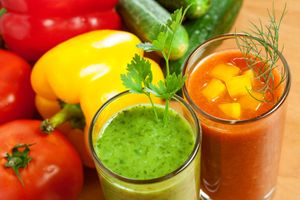This post was originally feature on US News & World Report website:

Take one look at your high school yearbook picture and then look at your reflection in the mirror. What you are about to read is going to explain the differences in the two images – and how your diet may help you get closer to the younger you.
Your skin’s two major proteins, collagen and elastin, age over time, which causes them to function less youthfully than they did at your high school graduation. Over time, your body’s natural antioxidant fighting capabilities can get overwhelmed by damaging oxygen-containing free radical molecules, which are naturally being generated in your cells as you age. These free radical molecules damage these two proteins causing aging structural and functional alternations in your skin cells. To make matters worse, environmental issues such as exposure to the sun’s ultraviolet rays, smoking and eating an unhealthy diet also generate additional free radical molecules that further damage your skin.
All this makes your skin look more frail and dry, and magnifies fine lines and wrinkles on your face. Hence, the differences in your yearbook picture and the mirror.
Enter the field of nutricosmetics, an emerging area in dermatology referring to the use of nutrition and nutritional supplements for skin health. “There is research that suggests that a healthy diet with specific nutrients can help reduce the signs of aging,” says Dr. Patricia Farris, a dermatologist and clinical assistant professor at Tulane University School of Medicine and spokesperson for the American Academy of Dermatology.
In other words, you don’t have to see a plastic surgeon to achieve youthful-looking skin. Just take it from registered dietitian and nutritionist Maye Musk, who at 70 years old, is a supermodel in high demand on runways and magazine covers. Musk attributes her daily sensible plant-based eating plan, similar to that of the Mediterranean diet, for her youthful skin and high level of daily energy similar to models half her age. “My healthy diet has served me well over the years,” claims Musk.
If you are interesting in learning more about nutricosmetics, here’s what the emerging research suggests:
- Pump up the vitamin C.
“Vitamin C is not only an antioxidant to fight free radicals, but is also needed to help enzymes make collagen,” Farris says. Research suggests vitamin C from foods can help regenerate skin cells, reduce wrinkles and fight against ultraviolet aging of your skin when exposed to sunlight. Research shows that diets rich in fruits and veggies, which are the major contributors of vitamin C in foods, have been associated with healthier skin among women.
What to Add to Your Plate: Head to the produce aisle for vitamin C. Red and green peppers, broccoli, vegetable juice, strawberries, citrus fruit and kiwis are all vitamin C powerhouses.
- Lean on linoleic acid.
In a study of 4,000 women, those with a diet higher in linoleic acid – the most abundant fatty acid in the skin – were less likely to experience skin thinning, which magnifies the wrinkles on the face. The older women in the study who had lower dietary intakes of both linoleic acid and vitamin C also had dryer skin.
What to Add to Your Plate: Since your body doesn’t make linoleic acid, you have to eat it. Soybean oil, canola oil, walnuts, almonds and edamame are chock-full of linoleic acid. Consume these with vitamin C-rich foods to get double the skin care effort.
- Eat less sugary foods.
Research confirms what you’ve probably noticed in yourself or others: A diet lower in added sugars and refined carbohydrates may help the skin look more youthful. By contrast, “a high-sugar diet can damage collagen and elastin fibers, causing them to lose their elasticity, leading to more wrinkles and sagging skin,” Farris says.
What to Add to Your Plate: Replace sugary treats and beverages with Mother Nature’s natural desserts: Watermelon, cantaloupe, grapes and pineapples. These foods also serve up antioxidants, which can squelch those ugly free radicals.
- Consider consuming more collagen.
Collagen is the most abundant protein in your body and can be found in animal foods such as poultry and meat. When you eat protein, it is broken down to amino acids. Once absorbed, your body reassembles these amino acids to meet all of your protein needs, such as creating specific hormones, enzymes, and the collagen in your bones, tendons, and skin. So, having a diet adequate in protein is good for your overall health including your skin.
Emerging research using nutritional supplements containing hydrolyzed collagen is beginning to show additional anti-aging, collagen-boosting promise. Research has shown that this type of hydrolyzed collagen is not broken down to amino acids, but rather, is absorbed intact. In this form, the hydrolyzed collagen can triggers cells to specifically generate more collagen and elastin in your skin. Stay tuned as more research comes in about these supplements.
What to Add to Your Plate: While a dietary protein deficiency is less likely in the American diet, you do need adequate protein to maintain good health. Choose lean sources of poultry, meat, fish and beans to meet your daily needs.
You may not be able to pass as a twin to your high school picture, but nutricosmetics is showing that your diet may help you slow down the aging process.